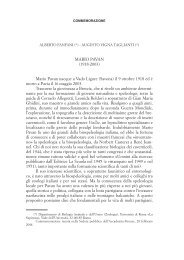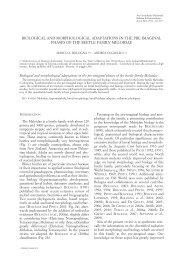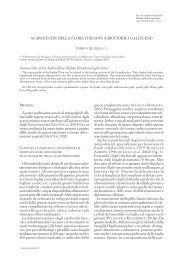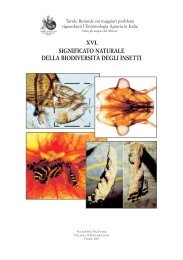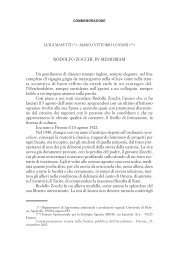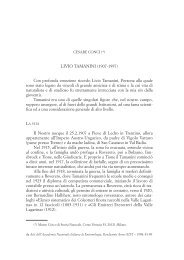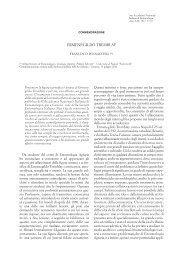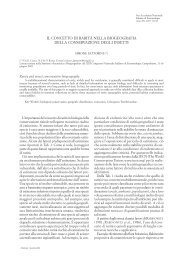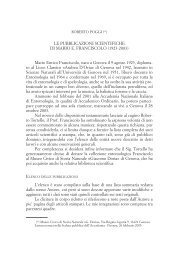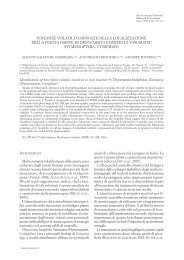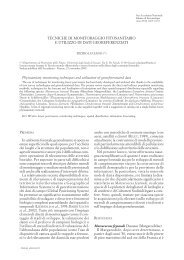XXII CNIE - Accademia nazionale italiana di Entomologia
XXII CNIE - Accademia nazionale italiana di Entomologia
XXII CNIE - Accademia nazionale italiana di Entomologia
Create successful ePaper yourself
Turn your PDF publications into a flip-book with our unique Google optimized e-Paper software.
Scientists converged on a subset deemed most consistent with the epidemiological<br />
evidence, which included the introduction of a new parasite or pathogen, exposure to<br />
pesticides, problems with nutrition, and/or exposure to stresses of contemporary<br />
beekeeping practices. A working group was constituted and an extraor<strong>di</strong>nary collective<br />
effort involving a large number of institutions was launched to investigate the<br />
phenomenon and identify its cause (Cox-Foster and van Engelsdorp 2009). This effort is<br />
still ongoing but even in this relatively short period of time a considerable amount of<br />
information has been obtained that can be applied to improve the general health and<br />
well-being of U.S. honey bees. In fact, as Kim Flottum, longtime e<strong>di</strong>tor of Bee Culture<br />
magazine, was moved to note, “beekeeping has changed more in the last two years than<br />
in the last 20” (http://www.thedailygreen.com/environmental-news/blogs/bees/colonycollapse-<strong>di</strong>sorder-88012901).<br />
Publication in 2006 of the honey bee genome sequence (Weinstock et al. 2006) provided<br />
new insights into potential vulnerabilities of Apis mellifera as well as powerful new<br />
tools to use in investigating possible causes of CCD. An evaluation of the honey bee<br />
revealed that suites of genes associated with immune responses (Evans et al. 2006) and<br />
detoxification (Clau<strong>di</strong>anos et al. 2006) are reduced in number relative to other insect<br />
species and may account for relatively greater vulnerability of honey bees to <strong>di</strong>sease and<br />
to pesticide poisoning. Thus, novel pathogens or novel pesticides were considered<br />
likely possibilities as causing or contributing to CCD.<br />
Pathogens?<br />
The rapid spread of CCD throughout the country, as well as unusual autopsy fin<strong>di</strong>ngs,<br />
suggested that a new pathogen may be the cause of bee <strong>di</strong>e-offs. Using an unbiased<br />
metagenomic approach, Cox-Foster et al. (2007) evaluated the microbial flora of honey<br />
bees in hives <strong>di</strong>agnosed with CCD, ostensibly healthy hives, and imported royal jelly.<br />
Can<strong>di</strong>date pathogens were analyzed to estimate the degree of association with a<br />
<strong>di</strong>agnosis of CCD. Bees afflicted with CCD were found to contain a variety of<br />
pathogens, the most pre<strong>di</strong>ctive of which was the Israeli acute paralysis virus (IAPV), a<br />
<strong>di</strong>cistrovirus not previously reported in the U.S. However, assigning a causative role to<br />
IAPV has been problematic as <strong>di</strong>fferences in symptomology argued against IAPV as the<br />
sole agent, and a later study found that IAPV had been present in the US bee population<br />
prior to the appearance of CCD (Chen et al. 2007). The metagenomic analysis identified<br />
other pathogens associated with CCD bees, inclu<strong>di</strong>ng Kashmir bee virus (KBV),<br />
deformed wing virus (DWV) and two species in the microspori<strong>di</strong>an genus Nosema.<br />
Indeed, the presence of multiple pathogens was a better pre<strong>di</strong>ctor of CCD than presence<br />
of IAPV alone. The high prevalence of multiple pathogens in CCD bees was consistent<br />
with the suggestion that a change in immune function may be integral to development of<br />
CCD.<br />
Another can<strong>di</strong>date pathogen suspected early on to play a role in CCD is the<br />
microspori<strong>di</strong>an pathogen Nosema ceranae. N. ceranae is a coevolved parasite of the<br />
Asian honey bee Apis cerana and there is considerable evidence that it has recently<br />
colonized A. mellifera in the U.S. and Europe, which, as a novel host, has little<br />
resistance. Although N. ceranae is very similar to Nosema apis, a longtime pathogen of<br />
Apis mellifera, in many ways, it causes a suite of symptoms that <strong>di</strong>ffer from N. apis<br />
infection, most notably in the swiftness of onset and absence of <strong>di</strong>arrhea-like<br />
gastrointestinal problems. Although stu<strong>di</strong>es in Europe documented that N. ceranae<br />
infections can lead to seemingly sudden collapses in the presence of ample brood, pollen<br />
and honey due to a long asymptomatic incubation period (Higes et al. 2008), the<br />
presence of N. ceranae in a high proportion of colonies in the U.S. considered to be free<br />
4



